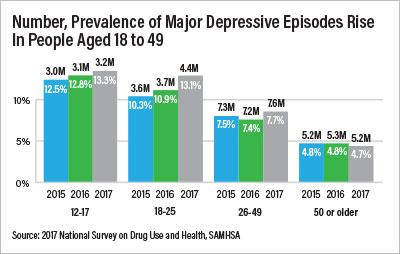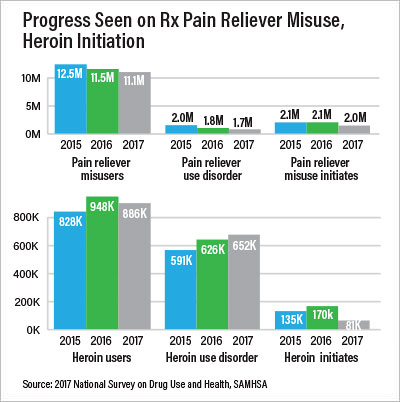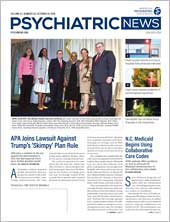Over the past few years, studies and media reports have painted a grim picture of the opioid epidemic in the United States. But the latest results of an annual survey by the Substance Abuse and Mental Health Services Administration (SAMHSA), released in September, show signs of progress in reducing opioid use.
The 2017 National Survey on Drug Use and Health (NSDUH) found that the number of people who started using heroin dropped by more than 50 percent between 2016 and 2017 (from about 170,000 to 81,000). In addition, people receiving specialty treatment for heroin use rose significantly between 2016 and 2017, from about 235,000 to 358,000. The survey defined specialty treatment as substance use treatment at a hospital (only as an inpatient), a drug or alcohol rehabilitation facility (as an inpatient or outpatient), or a mental health center.
The increase in people seeking help for heroin problems was part of a larger trend, as the number of people receiving specialty treatment for any opioid use disorder (OUD) rose sharply as well, from 453,000 (21.1 percent of all people with an OUD) in 2016 to 603,000 (28.6 percent) in 2017.
These positive developments are due in part to several initiatives implemented by SAMHSA over the past year in response to the 2016 NSDUH, according to Elinore McCance-Katz, M.D., Ph.D., assistant secretary for mental health and substance use in the Department of Health and Human Services. Among other items, the previous NSDUH reported rises in heroin use, use of fentanyl-laced compounds, and opioid overdose deaths.
Some of these new initiatives included establishing a state-targeted response program for the opioid crisis. Through this program, addiction professionals in each U.S. state and territory will receive SAMHSA support to help provide technical assistance and training to communities. SAMHSA has also changed its grant guidelines so that grantees can provide substance use services to incarcerated individuals prior to their release from prison.
The findings speak “to the emphasis that this administration has placed on addressing the opioid epidemic and to the focus that states and communities have had on making sure the needs of their people with opioid use disorder are being met,” McCance-Katz said in a recorded presentation of the latest data.
McCance-Katz cautioned that despite these positive signs, the burden of opioid use remains large. Deaths related to heroin use spiked in 2017: there were 15,549 heroin-related deaths reported in 2017, compared with 13,219 in 2016 and 13,101 in 2015. Additionally, McCance-Katz noted, heroin use represents only a small proportion of problem opioid use. The majority of the 11.4 million people in the United States with an OUD misuse prescription pain medication.
Substance Use Remains Source of Concern for Young Adults
The 2017 NSDUH also revealed an uptick in substance use by adults aged 18 to 25. Over the past two years, the rates of alcohol, cigarette, cocaine, methamphetamine, and LSD use have increased in this age bracket, whereas rates in younger (aged 12 to 17) and older (26 and up) individuals have remained relatively stable.
The number of adults aged 18 to 25 diagnosed with a major depressive episode (MDE) or serious mental illness also rose in 2017; 13.1 percent of adults aged 18 to 25 experienced an MDE in 2017 compared with 10.9 percent in 2016, while the prevalence of serious mental illness in this age group rose from 5.9 percent in 2016 to 7.5 percent in 2017. The number of youth receiving treatment for SMI also rose between 2016 and 2017, from 50.7 percent to 57.4 percent. “But, that still means 42.6 percent are getting no treatment, and that is unacceptable,” said McCance-Katz. “We will continue to focus on this issue, particularly as it relates to young adults.”
The NSDUH is an annual nationwide survey on the use of legal and illicit drugs and prevalence of mental disorders that has been conducted by the federal government since 1971. The NSDUH surveys approximately 67,500 civilian, noninstitutionalized Americans ages 12 and older every year through face-to-face interviews. The survey is designed to have the participants be representative of the whole nation as well as individual states and the District of Columbia. ■
The 2017 NSDUH report can be acccessed
here.


